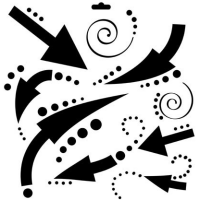 Using a tuning fork to indicate chords is difficult. Do we really have to? A lot a directors are scared for it, because it involves a lot of steps. First you have to understand the chord, next search for the root, imagine the right notes and sing the notes with a good intonation while looking at the voice groups. Indeed, it isn’t easy! Nevertheless, we should learn it! On a concert, you should be reluctant to indicate the notes of an a cappella with the piano. It just won’t fit and you will look unprofessional as a conductor.
Using a tuning fork to indicate chords is difficult. Do we really have to? A lot a directors are scared for it, because it involves a lot of steps. First you have to understand the chord, next search for the root, imagine the right notes and sing the notes with a good intonation while looking at the voice groups. Indeed, it isn’t easy! Nevertheless, we should learn it! On a concert, you should be reluctant to indicate the notes of an a cappella with the piano. It just won’t fit and you will look unprofessional as a conductor.
In this post we are focusing on the order in which the notes are indicated. A lot of directors start with the soprano. After all, it is polite to let the ladies go first. And most of the times the melody lies on top.
 In the past months, I using a new teaching form in my conducting lessons. Students used to take turns, standing in front of the group. But instead of that, now the group is forming a circle and each student gets a few minutes to work on the music. Below, I’m describing this work form in more detail.
In the past months, I using a new teaching form in my conducting lessons. Students used to take turns, standing in front of the group. But instead of that, now the group is forming a circle and each student gets a few minutes to work on the music. Below, I’m describing this work form in more detail. A good director is capable of deriving keys from the tuning fork. But doing so isn’t always easy. From the a of the tuning fork you would like to jump to the new root at once. However, not every interval is that easy to find. An ascending second or fourth is doable. But a sixth or a tritone, can be really hard to find.
A good director is capable of deriving keys from the tuning fork. But doing so isn’t always easy. From the a of the tuning fork you would like to jump to the new root at once. However, not every interval is that easy to find. An ascending second or fourth is doable. But a sixth or a tritone, can be really hard to find.  Rehearsing notes with a choir is not very enthralling. The director is singing the notes (or playing them on the piano) and the singers are repeating the notes. It may take a lot of time before all voice groups know their parts. Probably the director starts with the top part (because it often is the melody) and works his way down. By the time the basses have their turn, five or ten minutes may have passed.
Rehearsing notes with a choir is not very enthralling. The director is singing the notes (or playing them on the piano) and the singers are repeating the notes. It may take a lot of time before all voice groups know their parts. Probably the director starts with the top part (because it often is the melody) and works his way down. By the time the basses have their turn, five or ten minutes may have passed. A lot of choirs always stand in the same way, lining up from highest to lowest voice. However, this is not the ideal formation. Other positions may be preferred for acoustic reasons or because they will make it easier for the singers to hear each other well.
A lot of choirs always stand in the same way, lining up from highest to lowest voice. However, this is not the ideal formation. Other positions may be preferred for acoustic reasons or because they will make it easier for the singers to hear each other well.
 Using a tuning fork to indicate chords is difficult. Do we really have to? A lot a directors are scared for it, because it involves a lot of steps. First you have to understand the chord, next search for the root, imagine the right notes and sing the notes with a good intonation while looking at the voice groups. Indeed, it isn’t easy! Nevertheless, we should learn it! On a concert, you should be reluctant to indicate the notes of an a cappella with the piano. It just won’t fit and you will look unprofessional as a conductor.
Using a tuning fork to indicate chords is difficult. Do we really have to? A lot a directors are scared for it, because it involves a lot of steps. First you have to understand the chord, next search for the root, imagine the right notes and sing the notes with a good intonation while looking at the voice groups. Indeed, it isn’t easy! Nevertheless, we should learn it! On a concert, you should be reluctant to indicate the notes of an a cappella with the piano. It just won’t fit and you will look unprofessional as a conductor. Most choirs rehearse once every week. What is a good build-up for such an afternoon or evening? What is a reasonable number of songs to work on in a meeting?
Most choirs rehearse once every week. What is a good build-up for such an afternoon or evening? What is a reasonable number of songs to work on in a meeting?